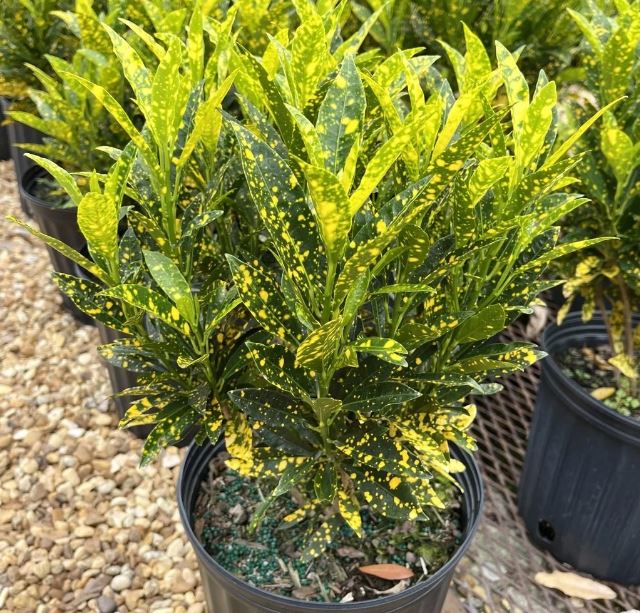
Croton is an extensive plant genus in the spurge family, Euphorbiaceae. The plants of this genus were described and introduced to Europeans by Georg Eberhard Rumphius. The common names for this genus are rushfoil and croton, but the latter also refers to Codiaeum variegatum. These plants are native to the tropical forests of Southeast Asia and the Pacific islands, including regions like Indonesia, Malaysia, and the Pacific islands.
The Gold Dust Croton features small, oval to lance-shaped leaves that are primarily green with numerous bright yellow spots scattered across them, giving the appearance of gold dust sprinkled over the leaves. This variegation pattern makes it stand out, offering a more subtle yet still vibrant look compared to other Croton varieties.
This plant tends to be more compact than some other Croton varieties, typically growing to about 2-3 feet in height when grown indoors. Its growth habit is bushy, which makes it a great choice for filling out spaces or creating a lush look. It thrives in bright, indirect light. While it can handle some direct sunlight, too much can scorch its leaves. Insufficient light will cause the yellow spots to fade, and the plant might revert to a more solid green color.
This plant appreciates higher humidity levels. You can increase humidity by misting the leaves, placing the pot on a tray with pebbles and water, or using a humidifier, especially in dry indoor environments. It prefers to dry out slightly between waterings. Overwatering can lead to root rot, so ensure the soil is well-draining. Water when the top inch of soil feels dry to the touch.
A well-draining potting mix is essential when growing this plant. A mix designed for tropical plants or a standard potting mix with added perlite or sand for better drainage works well. Moreover, It prefers warm temperatures, ideally between 60-85°F (15-29°C). It’s not frost-tolerant, so it’s best kept indoors in cooler climates or in a protected spot outdoors in warmer climates.
Care Tips
- Fertilization: Feed with a balanced, water-soluble fertilizer during the growing season (spring through summer) every 2-4 weeks. Reduce or stop fertilization in the fall and winter.
- Pruning: Pruning can help maintain its shape and encourage bushier growth. Remove any damaged or discolored leaves to keep the plant healthy and vibrant.
- Toxicity: Like other Crotons, the Gold Dust Croton is toxic if ingested, so it should be kept out of reach of pets and children.
- Pests: Watch out for common houseplant pests like spider mites, scale, and mealybugs. Regularly inspect and clean the leaves to prevent infestations.
Why Choose Gold Dust Croton?
- Aesthetic Appeal: Its speckled leaves offer a unique look that can add a touch of elegance and whimsy to any indoor space. The gold spots against the green background make it a standout plant.
- Ease of Care: While it has specific needs like most Crotons, the Gold Dust variety is relatively forgiving, making it suitable for both novice and experienced plant enthusiasts.
- Space Filler: Its bushy growth habit makes it excellent for filling out shelves, desks, or corners, providing a lush, green (and gold) environment.
- Air Purification: Like many plants, it can help improve indoor air quality by removing toxins, adding to its appeal as a functional decor element.